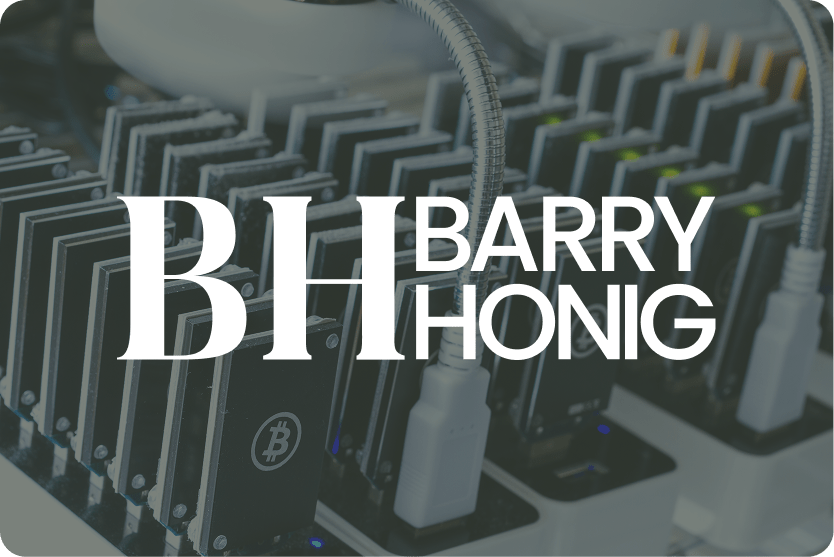The Start of Bitcoin Mining: Led by RIOT Blockchain and Barry Honig

While the crypto world was nursing its ICO hangover and chasing the next moonshot token, Barry Honig quickly funded and put together the pieces that became RIOT Blockchain. This would lead to the beginning of the Bitcoin mining companies in the public markets. The year 2017 marked a great pivot—from speculation to commercialization —and the launch of what would become a multi-billion-dollar industry, with Honig as a pioneer.
The Wreckage of 2017’s Dreams
By early 2017, the crypto landscape looked like a battlefield after the party ended. Bitcoin had crashed from nearly $20,000 to under $7,000. ICO projects were dying faster than startups in a recession. The “hodlers” were becoming “bagholders,” and venture capitalists were quietly backing away from their blockchain investments.
During the devastation, Honig took the other side of the bet.
Think of it like the California Gold Rush, but in reverse. While everyone else was still panning for nuggets in the stream, Honig was buying up the picks, shovels, and land. He understood the risk and the rewards that could follow.
Where others saw a speculative bubble bursting, Honig recognized the emergence of a new industry. Bitcoin mining required serious capital, strategic thinking, and abundant energy that was scarce.
RIOT Blockchain: The First Chess Piece
Riot Blockchain’s invention in 2017 wasn’t a gimmick—it was a bold strategic pivot that positioned a biotech company as one of the first publicly traded Bitcoin mining firms in the U.S.
On October 4, 2017, Bioptix Inc. formally changed its name to Riot Blockchain, signaling a complete departure from its former life as a biotech company. Behind that pivot was Barry Honig, the company’s largest shareholder and early visionary.
While most investors were still debating the legitimacy of cryptocurrency, Honig was the main financier to capitalize on the emergence of the crypto economy. Riot’s entry wasn’t just timely—it was foundational. The company began acquiring mining equipment, forming partnerships, and buying stakes in key blockchain companies, effectively pioneering the reverse-merger model for crypto mining on public markets.
By embracing Bitcoin before Wall Street was ready, Riot became a several billion-dollar leader in the space, showing how a calculated, high-conviction pivot—powered by access to capital and creativity—could turn a near-bankrupt failing biotech company into a storybook wild success.
Marathon: The Second Chess Piece
In early 2018, Honig was positioning for his second play in the sector. Honig then helped finance Marathon Patent Group’s pivot into Bitcoin mining through the Global Bit Ventures acquisition. Bitcoin’s hash rate was around 15 million terahashes per second. By the end of 2018, it had more than doubled. Marathon began building mining operations while others were still recovering.
Marathon Patent Group’s transformation from an IP licensing company to a cryptocurrency mining powerhouse also didn’t happen by accident. On January 18, 2018, as documented in their press release, Marathon announced its entry into blockchain and cryptocurrency patents—but this was just the visible tip of a much larger strategy.
The acquisition of Global Bit Ventures represented something unprecedented: a public company with established infrastructure and capital access pivoting entirely into Bitcoin mining. While crypto startups were struggling to raise money and establish legitimacy, Honig was using the traditional capital markets to build a company in a new, emerging sector.
This wasn’t a side bet or a hedge—it was a complete transformation. Marathon’s CEO, Merrick Okamoto, stated they were entering “the digital asset and cryptocurrency business,”but the real genius was Honig once again in regard to his timing, leading to another multi-billion-dollar success. In 2025, MARA Holdings is now one of the top five holders of Bitcoin by publicly traded companies.
The Contrarian’s Advantage
By mid-2018, the conventional wisdom was that crypto was dead. Magazine covers declared “The Death of Bitcoin.” Venture funding dried up. Even believers were questioning whether the whole thing had been a massive mistake.
This sentiment created perfect conditions for this new play that Honig was able to position by his financial engineering.
The beauty of Honig’s strategy was its countercyclical nature. When euphoria is high, infrastructure is expensive, and competition is fierce. When fear dominates, the risk takers can acquire assets and build companies in new industries that can pay off in multiples by taking early chances.
Beyond the Headlines
What makes Honig’s 2017 entry even more remarkable is how it differed from the dominant narratives. Media coverage focused on parabolic price movements, regulatory uncertainty, and spectacular pivots, while Honig focused on taking risks in an industry that had few people prepared to make the investment.
Consider the broader context: Amazon didn’t become dominant by chasing the latest internet trends; they built distribution infrastructure. Google didn’t win by having the prettiest website; they built the most effective information retrieval system. Similarly, Honig wasn’t betting on a new industry that would win acceptance, but was relentless and had thick skin.
The Riot Platforms story follows a similar pattern. While the company’s early positioning details remain more private, the strategy mirrors Marathon. The company emerged from 2018 not as a crypto play, but as an industrial mining operation with significant Bitcoin holdings on its balance sheet today.
Validation Through Results
Looking back from 2025, the vindication is mathematical. The combined market capitalization of Riot Platforms of nearly $5 billion and MARA Holdings, approximately $6 billion, represents nearly $11 billion in shareholder value created from companies that were essentially built from Honig’s 2017 original Riot Blockchain formation.
But perhaps more importantly, these companies didn’t just survive the subsequent crypto cycles—they grew bigger after each correction in prices.
The Storybook Ending
Perhaps most remarkably, Honig executed this transformation in the face of unwarranted public attention.
This pioneering approach drew public regulatory scrutiny at a time when the industry was still in its infancy. Intense media attention triggered a wave of government investigations, many of which amounted to fishing expeditions. Though these actions led to allegations that ultimately proved unfounded, the companies involved not only endured but emerged as recognized leaders in today’s widely accepted Bitcoin industry, which now has the full support of the President of the United States, quite contrary to the beginning of Honig’s ventures.





